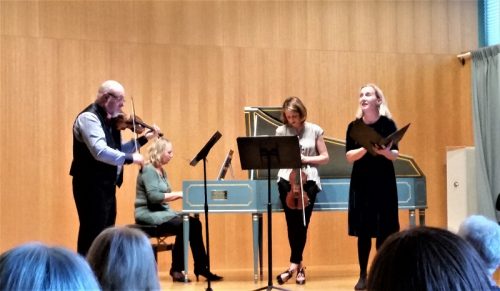
Music / “Scottish & Irish Baroque”, Sydney Consort, Wesley Music Centre, May 5. Reviewed by ROB KENNEDY.
SCOTTISH and Irish Baroque music may not be well-known but as this concert showed, their early music deserves an equal place alongside continental European baroque music.
The performers in the Sydney Consort were Josie Ryan, soprano Julia Russoniello, baroque violinist Stan W. Kornel and harpsichord player Monika Kornel.
The instantly recognisable sound of traditional Scottish music was heard in James Oswald’s (1710-1769) tunes and songs. This type of folk music can make a listener feel comfortable because it’s not overly complex or highly dramatic. The pleasant mellow music wafted clearly through the room in the Wesley Music Centre, and the jig’s made you want to dance and move.
The concert was interspersed with Irish and Scottish songs sung with much animation and delight by Josie Ryan, who has a masters degree in early vocal music.
The four Irish airs of Burk Thumoth (unknown-1747) sounded more like the traditional baroque music that most people know. All Thumoth’s music, as all the music in this concert, had a strong vocal character. The violinists took turns at performing pieces with harpsichord accompaniment. Stank Kornel got to blast out a solo jig in the tune “The Major” showing everyone just how good a player he is.
The sad Irish song “Silent O Moyle” fitted perfectly with Ryan’s mellow and expressive voice. It touched a few nerves in the audience with its hushed and haunting tones.
Nathaniel Gow (1727-1807) was a Scottish composer and fiddler. His “Lament” for the death of his second wife was not only an expression of grief but also a joyous piece with a touch of that distinctive Scottish Snap, which is a short, accented note followed by a longer note. Stank Kornel dedicated this lament to the memory of his mother who died last year at 94.
A collection of six Scottish tunes came next by William McGibbon (1690-1756). These pieces reflected a more tranquil side of the Scottish character with a lovely mellow tune about the heathered moorlands of Scotland. However, a toe-tapping jig stepped things up. Again all pieces were swapped between violinists and harpsichord then all three came together for the final swaying tune “There’s three good Fellows ayont yon Glen”.
Three pieces by Turlough O’Carolan (1670-1738), who is considered by many as the Irish national composer, exemplified traditional lively and happy music of the Irish. O’Carolan who journeyed from one end of Ireland to another for almost fifty years composing and performing his tunes on his harp had been blind since eighteen through smallpox.
Finishing off with an Irish song, “The Parting Glass” is a song that sounded like it was sung at the end of a night out with good friends. As the audience applauded this special concert of Scottish and Irish Baroque music, Stan Kornel let loose with a jig on his violin then the others joined in, with much toe-tapping from the audience.
Who can be trusted?
In a world of spin and confusion, there’s never been a more important time to support independent journalism in Canberra.
If you trust our work online and want to enforce the power of independent voices, I invite you to make a small contribution.
Every dollar of support is invested back into our journalism to help keep citynews.com.au strong and free.
Thank you,
Ian Meikle, editor




Leave a Reply